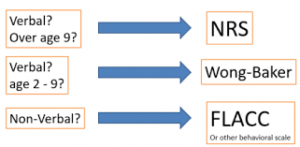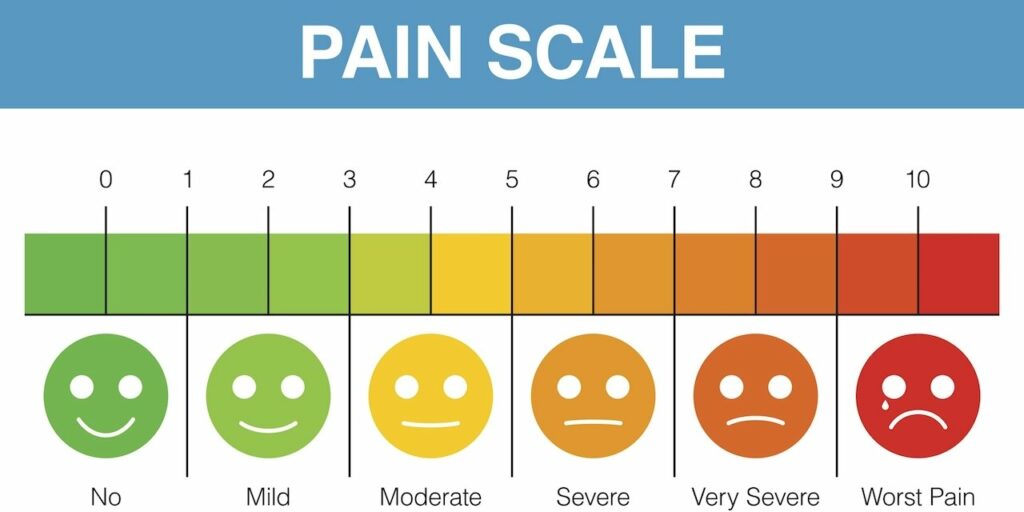The FLACC scale is a tool that is used to measure pain in adults. It stands for Face, Legs, Activity, Crying, and Consolability. This scale can be used to help health professionals determine the best way to treat a patient who is in pain. In this blog post, we will discuss how to use the FLACC scale and what each of the categories means. We will also provide examples of how to use the scale.
Contents
What Is the FLACC scale?

The FLACC scale (Face, Legs, Activity, Cry, Consolability) is a pain assessment tool designed for infants and young children. It uses five criteria to rate the severity of pain in children from 0-10: Face, Legs, Activity, Cry, and Consolability. The higher the score on each criterion, the more severe the pain is considered to be.
The Face criterion of FLACC assesses the number of facial expression changes and grimacing when a child is in pain. The Legs criterion looks at whether or not a child’s legs are moving and if they are, what kind of movements they are making. Activity measures how much energy the child is expending and if they are engaging in activities like playing or rocking. Cry looks at the nature, duration, and intensity of a child’s crying when they are in pain. The final criterion, Consolability, assesses how easily the child can be comforted when they are in pain.
How Does the FLACC Scale Work?

The FLACC (Face, Legs, Activity, Cry, Consolability) is an observational pain assessment tool designed to measure pain in infants and children between the ages of 2 months and 7 years old. The scale consists of five items that are scored from 0–2 based on the child’s observed behavior, for a total score between 0–10.
Face
The child’s facial expression is assessed for pain including grimacing, frowning, or eye squeezing.
Legs
The child’s leg movements such as kicking and drawing the legs up are evaluated.
Activity
How active the child is in comparison to their normal behavior is assessed.
Cry
The type and intensity of the child’s cries are evaluated, including whimpering, moaning, screeching, or screaming.
Consolability
How easily the child can be consoled is assessed by evaluating how effective comfort measures are in calming the child’s pain.
To use the FLACC scale, a trained healthcare provider observes the child and assigns each item on the scale a score from 0–2 based on their assessment. The scores are then added together to obtain a total pain score between 0–10. A higher score indicates greater intensity of pain.
How FLACC scale Is Used?
The FLACC scale is a pain assessment tool used to evaluate the intensity of pain in children who are too young to communicate their pain verbally. The acronym stands for face, legs, activity, cry, and consolability. This tool measures each parameter on a score from 0-2 with 0 being no pain present and 2 being severe pain present. The overall score is then determined by adding the individual scores together to create a total out of 10.
The FLACC scale has been used extensively in pediatric settings since its introduction in 1997 and is considered an accurate assessment of pain for children aged 0-7 years old. It is often used to evaluate patients who are unable to communicate their pain, such as those who are sedated, unconscious, or have cognitive impairments.
The FLACC scale is a useful tool for medical professionals in caring for children who are unable to communicate their pain levels. It can help provide objective evidence that assists in the treatment and management of pain in young patients. This can help ensure that children receive appropriate treatments and also provide insight into how their condition is responding over time. The FLACC scale can help to improve the accuracy and effectiveness of pain management in children who are unable to express their discomfort.
Once all parameters have been assessed, the scores should be totaled and recorded as the overall FLACC score. This score can then be used to determine the intensity of the pain being experienced by a pediatric patient.
Examples Of FLACC Scale
there are various examples:
Preterm Infant
This scale is used to assess the pain response of preterm infants in the NICU. It looks at five variables including facial expression, activity level, cry sound and quality, V, and color change.
Children with Autism Spectrum Disorder (ASD)
This scale is commonly used to assess pain in children with ASD. It looks at different behaviors that may be indicative of pain, such as increased agitation or distorted vocalizations.
Adults
This scale is used to measure the self-report of pain in adults. It evaluates five variables including facial expression, activity level, verbal response, touch sensitivity, and posture.
Animals
This scale is used to assess pain in animals, such as cats and dogs. It looks at behaviors like facial expression, vocalizations or growling, body posture, activity level, and reaction to touch.
In addition to these examples of how the FLACC scale can be used in various contexts, it is also important to recognize that the scale is easily adapted to different settings and populations. For example, if an individual has the limited verbal ability, a clinician may include less vocal assessments such as movement or body language in the assessment. Ultimately, it is important for clinicians to use their clinical judgment when assessing pain levels with the FLACC scale.
How It Is Important?
The FLACC is a simple framework for measuring pain behaviors in children who may not be able to verbalize the presence or severity of pain. Early data suggests that the FLACC tool is valid and reliable.
The pain scale is a doctor’s best tool to understand a patient’s pain. Different aspects such as severity, duration, and type all help the doctor make an accurate diagnosis. With this information, they can create an effective treatment plan that addresses the patient’s needs.
How It Is Beneficial?
It is important in the following ways:
Simple and effective tool
The FLACC scale is a simple and effective tool to measure pain in infants, children, and those with cognitive impairments. It provides an objective measure of pain based on observations of five behavioral components that are known to be associated with the experience of pain.
Assess all types of pain
It can be used to assess all types of pain and discomfort, from post-operative pain to chronic conditions such as sickle cell anemia. FLACC is especially useful for assessing pain in infants who are unable to verbalize how they are feeling.
Better informed decision
It helps to ensure that the child’s pain is taken into account when making treatment decisions and helps clinicians make better-informed decisions about the best course of treatment for their patients.
Used in any setting
It is also beneficial because it can be used in any setting – at home, in the hospital, or even while traveling. This makes it a very convenient and versatile tool that can be utilized by caregivers, nurses, and doctors alike.
Finally, the FLACC scale can be used to monitor pain over time, allowing for the effectiveness of treatments to be monitored. This is especially important for chronic conditions such as sickle cell anemia, which require frequent monitoring in order to ensure that treatments are meeting the patient’s needs.
Overall, the FLACC scale is a useful tool for assessing and monitoring pain in infants, children, and those with cognitive impairments. It can help to ensure that the child’s pain is taken into account when making treatment decisions and allows for better-informed decisions about the best course of action. Furthermore, its versatility enables it to be used in any setting, making it a convenient and effective tool. By utilizing the FLACC scale, clinicians can have a better understanding of their patient’s pain and be better informed in managing their condition.
Limitations
There are various limitations of the FLACC scale. They are as follows:
1. It is not suitable for infants less than two months old, as they do not have the developmental capabilities to display certain behaviors that are measured in the scale.
2. The FLACC scale does not take into account underlying medical conditions that can affect pain scores. For example, many neurological and genetic disorders and diseases can lead to an altered pain experience in a patient, which is not considered in the FLACC scale.
3. The reliability of the scale can be affected by inter-observer variability. This means that different observers may give different scores when observing the same patient, thus resulting in an inaccurate measure of pain intensity.
4. It does not take into consideration the experience of chronic or lasting pain. The FLACC scale is best for measuring acute pain in a single session and does not provide an accurate measure of long-term pain intensity.
5. Finally, there are certain situations where the use of the FLACC scale may be inappropriate, such as when a patient is unconscious or unresponsive. In such cases, other methods of pain assessment must be used.
Thus, it is important to take all the above limitations into account when using the FLACC scale in order to ensure accurate and reliable measures of pain intensity. With proper use and interpretation, however, the FLACC scale can still provide a useful tool for assessing acute pain in patients.
Conclusion
In conclusion, the FLACC scale can be a useful tool for assessing acute pain in patients. However, it is important to understand the limitations of the scale and use it in conjunction with other assessment tools for a comprehensive understanding of pain intensity. With proper use and interpretation, the FLACC scale can provide an objective measure of acute pain that can be used to develop an effective treatment plan.
This article has provided an overview of the FLACC scale and its various uses, limitations, and applications. By understanding the FLACC scale and how to use it appropriately, healthcare professionals can gain a better understanding of acute pain in patients, allowing them to develop effective treatment plans that are tailored to individual patients’ needs.
Physical Therapy help patients recover from pain. If you’re experiencing Back pain, Shoulder pain, Knee pain, Neck pain, Elbow pain, Hip pain, or Arthritis pain, a physical therapist at MantraCare can help: Book a physiotherapy session.


